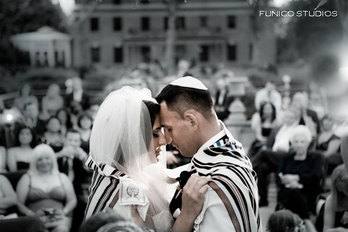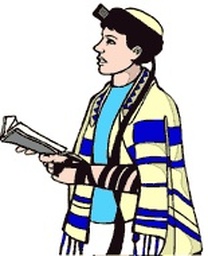
Prayer Shawl for a Wedding (Tallit) is a great gift. Traditional Jewish weddings are always conducted beneath a wedding canopy called a chuppa in hebrew. The custom of using a prayer shawl as the chuppa dates back to ancient biblical times.
A prayer shawl, called a tallit in hebrew brings a personalized element to the ceremony. This is especially true when the prayer shawl belonged to the father or grandfather of the bride or groom. Once the couple is married the prayer shawl becomes a treasured family heirloom that often gets passed down to the next generation to use as their wedding chuppa.
Genarally, there are two distinct types of prayer shawls worn by religious men. A small sized prayer shawl is referred to as a "tallit katan" meaning small prayer shawl in hebrew. It is worn by a Jewish male beginning on his third birthday. He will typically wear it underneath his shirt with the four fringes(tzitzit in hebrew) either exposed or tucked inside of his pants. The second type of prayer shawl is called "tallit gadol" which is the hebrew term for large prayer shawl. A religious Jewish man wears the small prayer shawl until he gets married and wears the large prayer shawl once he is married. A common traditional wedding ritual is that the bride to be buys a prayer shawl as a gift for her future husband's religious use throughout the rest of his life. The gifted prayer shawl is first used as their wedding canopy on their special day and is subsequently worn by the husband thereafter.
In order to utilize the large prayer shawl as a chuppa, it must be suspended by four poles by carefully inserting them in through the existing holes at the four corners of the prayer shawl where the fringes are attached. Each of the four poles or sticks is hand held by members of the wedding party. Customarily, the individuals chosen for this honor are unmarried and it is believed that their participation in the ceremony will increase the likelihood that they will find brides to marry in the near future. The prayer shawl, wedding canopy represents G-d's divine presence signifying the holy sanctity of their marriage. Jewish weddings are often conducted outdoors to fulfill a Torah mitzvah (law) of being married beneath the heavenly stars.
The chuppa has no walls and is open and accessible from all four sides. This is symbolic of the hospitable nature of a Jewish home that welcomes others who may come from any direction. This prayer shawl canopy harkens back to the patriarch Abraham and his wife, matriarch Sarah who together warmly welcomed all into their home. Also, the design for the chuppah tallit is done in a way that it lacks any furniture or unnecessary ornaments. This is to convey the simplicity of the Jewish family who values love and kind deeds over material possessions.
To get your prayer shawls click this link: http://prayershawl.weebly.com/mens-prayer-shawl.html
A prayer shawl, called a tallit in hebrew brings a personalized element to the ceremony. This is especially true when the prayer shawl belonged to the father or grandfather of the bride or groom. Once the couple is married the prayer shawl becomes a treasured family heirloom that often gets passed down to the next generation to use as their wedding chuppa.
Genarally, there are two distinct types of prayer shawls worn by religious men. A small sized prayer shawl is referred to as a "tallit katan" meaning small prayer shawl in hebrew. It is worn by a Jewish male beginning on his third birthday. He will typically wear it underneath his shirt with the four fringes(tzitzit in hebrew) either exposed or tucked inside of his pants. The second type of prayer shawl is called "tallit gadol" which is the hebrew term for large prayer shawl. A religious Jewish man wears the small prayer shawl until he gets married and wears the large prayer shawl once he is married. A common traditional wedding ritual is that the bride to be buys a prayer shawl as a gift for her future husband's religious use throughout the rest of his life. The gifted prayer shawl is first used as their wedding canopy on their special day and is subsequently worn by the husband thereafter.
In order to utilize the large prayer shawl as a chuppa, it must be suspended by four poles by carefully inserting them in through the existing holes at the four corners of the prayer shawl where the fringes are attached. Each of the four poles or sticks is hand held by members of the wedding party. Customarily, the individuals chosen for this honor are unmarried and it is believed that their participation in the ceremony will increase the likelihood that they will find brides to marry in the near future. The prayer shawl, wedding canopy represents G-d's divine presence signifying the holy sanctity of their marriage. Jewish weddings are often conducted outdoors to fulfill a Torah mitzvah (law) of being married beneath the heavenly stars.
The chuppa has no walls and is open and accessible from all four sides. This is symbolic of the hospitable nature of a Jewish home that welcomes others who may come from any direction. This prayer shawl canopy harkens back to the patriarch Abraham and his wife, matriarch Sarah who together warmly welcomed all into their home. Also, the design for the chuppah tallit is done in a way that it lacks any furniture or unnecessary ornaments. This is to convey the simplicity of the Jewish family who values love and kind deeds over material possessions.
To get your prayer shawls click this link: http://prayershawl.weebly.com/mens-prayer-shawl.html

 RSS Feed
RSS Feed